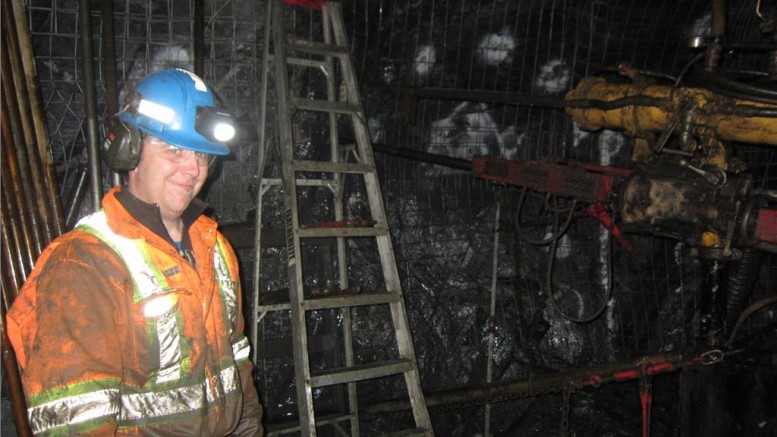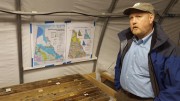BATHURST, N.B.— Trevali Mining (TSX: TV; US-OTC: TREVF) is nearing commercial production at its past-producing Caribou zinc-lead-silver mine in New Brunswick, ahead of what the company expects will be an uptick in zinc and lead prices, helped by looming mine closures of aging mines.
Trevali — which brought its 2,000-tonne-per-day Santander zinc-lead-silver mine in Peru in full production last year — is headed towards that same goal at its 3,000-tonne-per-day Caribou operation in early 2016.
“So we are pretty much there,” Mark Cruise, the company’s president and CEO, said during the drive to the site on a September media tour.
Once in full swing, Caribou should produce 93 million lb. zinc, 32.5 million lb. lead, 3.1 million lb. copper, 730,000 oz. silver and 1,500 oz. gold annually for a little over six years, at operating costs of US65¢ per lb. zinc, after by-products and royalties.
The 130 sq. km Caribou property sits in Restigouche County in the northern part of the province. It is accessible via Highway 180, which links the cities of Bathurst and Saint-Quentin. After driving 50 km west of Bathurst, we turn onto a 4 km long gravel road that leads to the mine site.
Caribou comprises two past-producing open-pit lead-zinc-silver mines and an underground mine. It has been intermittently in production since the seventies. Between 1970 and 2008, Caribou cranked out an estimated 2.3 million tonnes grading 6.6% zinc and 3.1% lead under several operators.
Its previous operator was Blue Note Metals. Between 2006 and 2008, Blue Note invested $100 million to upgrade the mine infrastructure and install specialized grinding components at the mill. It ran Caribou for a little over a year, before filing for bankruptcy in 2008. A year later, private firm Maple Minerals took ownership of the asset, but did not restart it.
Around this time, Trevali made a positive development decision for its Santander mine, and looked for other zinc-rich deposits to diversify its asset base a bit.
“One-mine operations are inherently risky,” Cruise concedes. “So the idea was: well, let’s look for another camp or another opportunity where we think we can get first-mover status, or at least acquire a significant position to dominate that camp at a local level and move forward. We always liked the Bathurst camp, and again, there wasn’t much competition there.”
Xstrata and its predecessor — now part of Glencore — were then the biggest players in the Bathurst mining camp with their Brunswick 12 operation, which closed down in 2013. “That [mine] was probably responsible for 2–3% of the world’s zinc supply, and mined for a good 60 to 70 years,” Cruise says during a presentation at the Caribou office.
Other past-producing mines in the camp were Heath Steele, Brunswick 6 and Caribou. Other deposits included Halfmile and the past-producing Stratmat mine.
Trevali ventured into the Bathurst camp via a 2011 merger with Kria Resources, picking up Halfmile and Stratmat.
A year later, it initiated trial mining at the fully permitted Halfmile underground mine. It processed more than 100,000 tonnes on a toll basis through the now-closed Brunswick 12 mill — 40 km away — producing saleable zinc, lead-silver and copper-gold concentrates.
Cruise reveals he contemplated using the Brunswick 12 mill once the mine wound down. “But it was just too big, and too old. And our mines were too small. So it didn’t make sense. That is when we looked at Caribou more seriously.”
Trevali bought the Caribou deposit, mill and related infrastructure via a $22-million equity takeover of Maple Minerals in November 2012.
Former operator Blue Note left the mill in “pretty good shape,” as it thought it would restart the operation after negotiating its debt. While that didn’t happen, it made Trevali’s job easier. “We’re lucky and thankful that they did that. Otherwise it would have been a lot more capital to get the mill back up and running,” the company’s vice-president of investor relations Steve Stakiw says before we suit up and take a tractor down the mine portal.
The temperature cools as we descend a couple hundred metres underground, passing an ore truck and a few drillers working on a 10,000-metre drill program that started in August. Trevali’s goal with the program is to upgrade and better delineate the current resource, as well as test for mineralization.
The junior has 220 people on-site, including 90 underground. About 15% of its current workforce are First Nations members.
With its work cut out at the mill and 10 km of underground development in place when it arrived, Trevali assessed Caribou as a stand-alone operation. Now, it’s evaluating the possibility of building another mill down the road for the combined Halfmile–Stratmat deposits.
A resource estimate in 2013 shows Caribou has 7.2 million measured and indicated tonnes grading 6.99% zinc, 2.9% lead, 0.4% copper, 84 grams silver and 0.9 gram gold per tonne for 1.1 billion lb. zinc, 468 million lb. lead, 69 million lb. copper and 19.6 million oz. silver.
It has 3.7 million inferred tonnes at 6.95% zinc, 2.8% lead, 0.3% copper, 78 grams silver and 1.2 grams gold for 560 million lb. zinc, 227 million lb. lead, 26 million lb. copper and 9.2 million oz. silver.
A May 2014 preliminary economic assessment (PEA) pegged initial costs to bring Caribou back online at $36.3 million, and life-of-mine sustaining capital at $88.8 million.
It calculated Caribou’s base-case, after-tax net present value at $106 million and internal rate of return at 56.9%, using zinc and lead prices of US$1 per lb. and a 5% discount rate.
Despite today’s lower metal prices, Cruise explains the project’s economics are relatively the same today, as the study assumed a US95¢ Canadian–U.S. dollar exchange rate. “Fortunately, the loonie [currently trading at US75¢] has dropped as much as the base metals effectively in the interim period,” he notes.
Trevali — the only primary zinc producer on the TSX — kicked off underground mining in March 2015, and started commissioning the mill in May, using low-grade stockpiled feed.
The milling complex includes a new 3,000-tonne-per-day semi-autogenous-grinding mill, two refurbished ball mills and three IsaMills, as well as the zinc and lead flotation circuits.
The IsaMills — installed by Blue Note in 2007 — make the mine “a little bit unique in North American terms,” Cruise points out. “They just look like 40 gallon drums, but what they do is they grind very finely. That has always been the challenge with the Caribou mine. You have to grind [the ore] very fine to get the liberation, and get your recoveries up.”
Given IsaMills are not common in Canada, the company retained DRA Americas Inc.— a South African specialist metallurgical and plant operations group — to provide training and support during commissioning. It also accessed its partner Glencore’
s metallurgical teams for support.
Trevali began producing zinc and lead-silver concentrates from Caribou in July. It is ramping up and improving mill recoveries to reach PEA design levels of 84% zinc and 65% lead.
During the third quarter, mill recoveries were 61.1% zinc and 41% lead. Production totalled 12,464 tonnes of zinc concentrate grading 48.8%, and 4,240 tonnes of lead concentrate grading 35.7%.
Recoveries climbed in October, but milling rates fell as the company pulled back throughput, while transitioning the mill feed from the low-grade stockpile to the higher-grade run-of-mine material, which familiarized its team with the material, Stakiw says. It also ironed out some wrinkles in its zinc circuit.
In November, mill throughput was well above 2,000 daily tonnes, with 78% and 60% zinc and lead recoveries. Mining rates were 1,950 tonnes per day, up from September’s 1,350 tonnes per day.
After the underground tour, we walk through the milling complex, where the crushed underground ore is ground further, treated and separated into zinc and lead-silver concentrates.
The products are stored on-site, until they are shipped to Belledune, N.B. Once there, the lead-silver concentrate goes into Glencore’s Belledune smelter, while the zinc concentrate goes by rail to the Noranda Income Fund’s (TSX: NIF.UN) CEZ refinery and smelting complex in Salaberry-de-Valleyfield, Que.
Glencore buys all of the concentrates from Caribou and Santander at market price under long-term offtake agreements.
Trevali’s relationship with the global commodity trader and miner goes back to 2010, when it bought Glencore’s 2,000-tonne-per-day mill for Santander on a lease-to-own basis, and signed a long-term concentrate offtake agreement for the mine.
Two years later, the major loaned Trevali $20 million to help commission the Santander mine, and signed an offtake agreement for Caribou.
More recently, it gave Trevali a one-year break from the finance lease payments on the Santander mill until Oct. 30, 2016 — or when zinc prices go back to US90¢ per lb. — for an average of 10 days.
“What we’ve seen in the market is that zinc has come down … in unison with the rest of the metals out there — but the fundamentals in the background are maybe one of the strongest, in terms of where it is forecasted,” Stakiw says.
While spot zinc prices recently fell to lows of US68¢ — or US$1,500 per tonne — on the back of global economic uncertainty, perceived demand and a stronger U.S. dollar, Stakiw points out that up to 1.5 million tonnes of zinc mine production — 10% of the world’s 14 million tonnes of annual production — could come offline shortly.
In November, Nyrstar said that if zinc prices stayed weak it would lower its annual zinc concentrate production by 400,000 tonnes, or even leave the mining business.
In October, Glencore lowered its contained zinc mine production across its operations by 500,000 tonnes a year (including 100,000 tonnes of lead output) to preserve its reserves in the low-priced environment.
While Glencore’s move is temporary, the world’s two largest zinc mines — Century in Australia and Lisheen in Ireland — are permanently closing by year-end. They produce a combined 675,000 tonnes of zinc concentrate a year.
Analysts say the zinc price will increase over the next four to five years as demand outstrips supply, creating a deficit.
“The metal market is already in a structural deficit, which is being addressed by stock draws, which currently meet the shortfall,” Raymond James analyst Alex Terentiew writes. “We believe a strong upside in prices is required to avert the implied dip in metal stocks to less than one week of consumption by 2019,” he adds. Terentiew predicts zinc prices should increase to US$1.21 per lb. in 2016, gradually climbing to US$1.53 in 2019.
This outlook bodes well for Trevali, with some analysts forecasting that with every cent per pound that zinc prices move, the company’s net asset value per share moves 3¢.
According to mining research and consulting firm Wood Mackenzie, zinc consumption should increase by more than 3 million tonnes over the next five years, with zinc prices estimated to reach US$3,600 per tonne, or US$1.60 per lb.
Meanwhile, Trevali is nearing the finishing line at Caribou, with both the mine and mill running above 2,000 tonnes per day in late November. Underground mining has benefitted from a fleet of 40-tonne trucks and increased production per stope, exceeding planned rates of 500 tonnes per day.
Caribou is transitioning to owner-operated. The operation should reach 2,500 daily tonnes by year-end, followed by 3,000 daily tonnes in early 2016.
Around this time, Trevali plans to install the copper circuit so that it can make copper-gold concentrate. Meanwhile, its 10,000-metre underground drill program should continue until mid-2016.
Cruise points out the deposit remains open at depth, with deep drilling returning massive sulphides 450 metres below the current defined resource. He says adding another couple years to the six-year mine plan “won’t be a stretch.”
During trading on Nov. 26, Trevali was up 8% at 34¢ per share, as spot zinc and lead prices rose slightly to US72.2¢ per lb. and US74.3¢ per lb., after reports that China would stock up on base metals.
The stock’s average price target — based on six analysts — is $1.15, including a 70¢ target by Scotiabank and $1.70 target by GMP Securities.
Trevali ended September with a $16-million cash position, including $8 million in restricted cash.






Be the first to comment on "Site Visit: Trevali nears full production at Caribou"